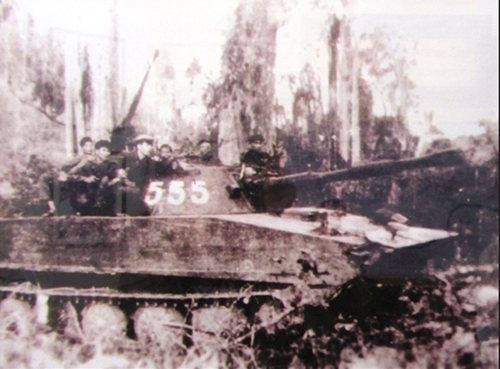This was a key battle taking place on February 6 and 7, 1968, in the first phase of the campaign, leaving valuable experience in military art, especially in choosing right targets and flexibly using combined-arms strength.
    |
 |
|
Tank number 555 made excellent achievements in the battle of Vay village, February 1968 (Archived photo) |
Vay Village is 8km west of Huong Hoa district. This was a strong point in the enemy’s defensive system of Road 9 - Khe Sanh, with the aim of protecting their Ta Con base. The base was built on two heights, No.320 and No.420, about 2km from the old Vay Village base (which was destroyed in May 1967), and was occupied by a commando and spy battalion of the Saigon regime. Namely, the No.420 was the outpost managed by a scout platoon. Meanwhile, the No.320 - the main stronghold - consisted of six zones with 21 blockhouses and a number of shelters, underground bunkers, connected together by trenches, as well as barbwire fences and various minefields. The enemy’s force had four reconnaissance companies, an American platoon, and was equipped with a large amount of heavy weapons. At the same time, the Vay Village base would recieve fire support from Ta Con base’s artillery force, an artillery unit stationed on Height No.241, and the enemy’s air force if requested.
Although the enemy had the advantage over the Vietnamese troops in weapons, especially in fields of artillery and air force, they could not exploit their staffed firepower and maneuver capability due to local mountainous terrain. Meanwhile, Vietnamese troops could master guerilla tactics. Because the enemy forces in Vay Village were divided into separate groups, so we could easily attack and isolate them. As the enemy had not been reinforced after we liberated Huong Hoa district on January 20, 1968 and lifted the blockade of Road 9, our force decided to attack Vay village base to encircle Ta Con base. If Vay Village base was defeated, the enemy stationed in Ta Con base would be isolated. Therefore, choosing Vay Village base as the key battle target of the campaign was completely a right decision.
In this situation, Vietnamese troops applied suitable military art. One of the new features was that we flexibly applied combined-arms strength, in which for the first time we used an array of modern weapons, namely tanks (16 PT-76s), an artillery battalion, and an anti-aircraft artillery company. On the night of February 6, 1968, after shelling Vay Village base, our tanks simultaneously attacked in all directions. In the main attack direction, Battalion 3, Regiment 101, Infantry Division 325, reinforced with tanks from friendly units, entered the base’s center after just 10 minutes. On the Western direction, Battalion 5, Regiment 24, Infantry Division 304 used tanks to destroy bunkers and breached the enemy’s defensive line. In the Northeastern direction, Battalion 4, Regiment 24 faced fierce resistance by enemy troops from two bunkers. The unit then counterattacked with anti-tank grenade launchers and then advanced to the enemy’s base. At 10:00 on February 7, 1968, Vietnamese troops occupied the base and concluded the battle.
The victory of Vay Village marked a milestone in our military art. We successfully chose the right target, used an infantry regiment, reinforced with technical equipment (including tanks for the first time) and flexibly applied combined-arms operation in mountainous areas. We successfully combined strength of infantry force with tanks, artillery and engineering forces. The victory paved the way for the following operations, leading to the success of the Road 9 - Khe Sanh Campaign.
Translated by Minh Anh